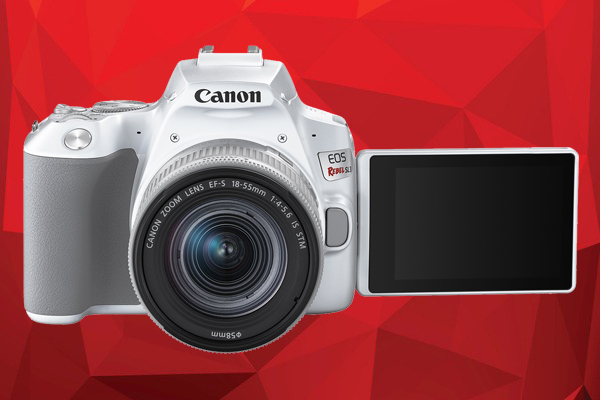Canon’s EOS Rebel SL3 is the market’s lightest and smallest EOS DSLR camera (available in both white and black). This new installment is an upgrade from the line’s last iteration, the Rebel SL2, that came out in June 2017. These two models are very similar with a pair of key upgrades detailed below.
Canon SL3 vs Canon SL2
|
Rebel SL3 |
Rebel SL2 |
|
| Sensor |
24.1 Megapixel CMOS APS-C Sensor |
24.2 Megapixel CMOS APS-C Sensor |
| Image Processor |
DIGIC 8 Image Processor |
DIGIC 7 Image Processor |
| Video |
4K / 23.98 fps |
Full HD 1080p |
| ISO Range |
100 – 25,600 |
100 – 25,600 |
| FPS |
5.0 fps |
5.0 fps |
| AF Points |
9 |
9 |
| Aspect Ratio |
3:2 |
3:2 |
| Dimensions (W x H x D) |
4.82 x 3.65 x 2.75 in. 122.4 x 92.6 x 69.8mm |
4.82 x 3.65 x 2.75 in. 122.4 x 92.6 x 69.8mm |
| LCD Monitor Size |
3.0-inch |
3.0-inch |
| LCD Monitor Pixels |
Approx. 1.04 million dots |
Approx. 1.04 million dots |
| Weight |
Approx. 15.84 oz. / 449g |
Approx. 15.98 oz. / 453g |
| Dual Pixel CMOS AF |
✓ |
✓ |
| 180° Tilting LCD Screen |
✓ |
✓ |
| WiFi / Bluetooth® |
✓ |
✓ |
| 3.5mm Stereo Mini
Microphone Jack |
✓ |
✓ |
| Touchscreen Interface |
✓ |
✓ |
| NFC |
N/A |
✓ |
Key Differences
At first glance, the Canon SL3 and SL2 look very similar because, well, they are. However, there are a couple of key features worth noting including video quality and image processing.
Video
The SL3 is the first Rebel camera that touts 4k video (the SL2 only shoots 1080p). This is an important upgrade that keeps the Rebel series in competition with other entry-level DSLRs.
Image Processor
The SL3 comes with an updated image processor; the SL2 uses the DIGIC 7 and the SL3 has the DIGIC 8. That change facilitates faster and more accurate dual pixel CMOS AF and Eye Detection AF.
Feature Highlights
The features listed below aren’t new to the SL3. However, they’re important highlights of the SL2 and SL3’s overall usability.
Dual Pixel CMOS Autofocus
If you’re researching Canon cameras, you’ve undoubtedly seen “Dual Pixel Autofocus” listed as a key feature. It’s one of those phrases you see and think, “I don’t know exactly what that is…but it sounds important and I want it.”
That is both a safe and correct assumption.
Dual Pixel CMOS autofocus is a Canon-exclusive, focus-tracking feature. More specifically, it improves shooting in Live View and is designed to provide smoother, sharper focus tracking when you or your subject is moving.
So, how does it work? Basically, each pixel on the sensor has two dedicated photodiodes (the element that converts light to an electrical current); normally, a pixel only has one photodiode.
When you record something with your Canon camera, those dual photodiodes work independently and send separate signals with different information about the shot’s focus. Finally, those two separate signals are combined to form one video or photo with a hyper-accurate, consistent focus.
An apt comparison would be calling in two doctors to get the best possible diagnosis rather than relying on one.
180° Tilting LCD Screen
The Canon EOS Rebel SL3 has a 3.0″ vari-angle LCD screen that turns to facilitate easy selfies. It’s also touch-sensitive so you can focus and zoom or swipe through images after you’ve taken them.

Video Stabilization
The SL3 has built-in, 5-axis video stabilization. Sadly, this feature doesn’t extend to still photography just yet. However, when recording video, it helps you capture smooth footage while you’re on the go.
























